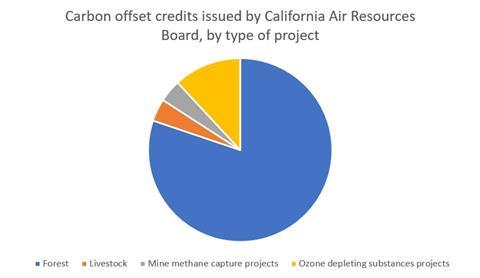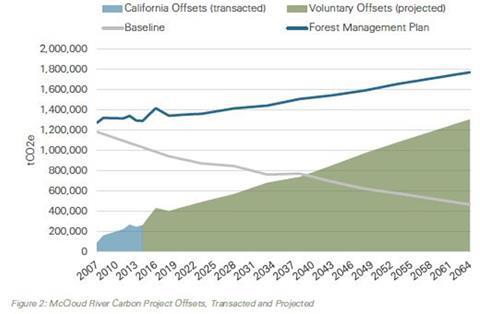Case study by Campbell Global
Campbell Global (CG) is a global investment manager focused on forest and natural resources investments. Based in Portland, Oregon, with offices in 14 U.S. states and New Zealand, the firm has nearly four decades of experience in sustainable value creation. We seek to drive sustainable outcomes in the forests we manage and in the communities where our staff live and work. Our approach to responsible investing includes delivering climate benefits from carbon sequestration and forest restoration.
Why bring forest projects to carbon markets
A forest’s natural capacity to reduce and offset carbon dioxide (CO2) has long captured the interest of policy makers, regulators, and other key stakeholders. Momentum has grown since the 2015 Paris Agreement on climate change, which explicitly recognised the critical role that healthy forests can play in storing CO2 on a global scale. Working forests also produce clean air and provide clean water, wildlife habitat and a source of living-wage jobs in rural communities.
The emergence of regulated markets, also referred to as cap-and-trade programmes, allow for the commoditisation of sequestered forest carbon for trade in the marketplace. Forest carbon offsets are now eligible for use in such programmes across 13 countries, and voluntary markets are rapidly growing to meet the sustainability goals of corporate entities.[1] For timberland owners, carbon markets present a unique opportunity to capture additional value by monetising the carbon stored in forests or retaining the offsets for their own carbon balance sheet. Today, forest carbon projects account for 81% of carbon offset projects registered under the California cap-and-trade programme (Figure 1).

How we measure carbon stored beyond business as usual
We have identified a pathway to create added value for our managed properties by developing forest carbon sequestration projects. These can monetise the inherent value of their ecosystems through the sale of carbon offsets into regulated and voluntary markets, while at the same time continuing to improve the health and ecological integrity of the properties. The projects involve several steps to ensure the credibility of the claims made for their environmental benefits.
To start, the successful development of these projects requires establishing a programme to monitor, verify and account for offsets sequestered above a baseline condition (e.g. business as usual practices). This framework and the associated methodologies allow for quantification of the “additional” carbon stored by implementing an alternative forest management regime.
This estimate is then verified through multiple steps, including third-party reviews of the forest carbon inventory field work as well as the calculations made to determine the amount of carbon sequestered. Subsequently, desk audits may be conducted by relevant regulatory bodies to affirm the proper execution of offset protocols and compliance with requirements for project-level monitoring and reporting. Generally, verifications occur on three to five-year intervals, depending on the amount of carbon sequestration that occurs on each property. Finally, verified offsets are released for sale into the appropriate markets.
Example: The McCloud River Project
In 2007, CG acquired on behalf of a client the McCloud River timberland asset in northern California, which had previously been managed primarily for timber production. The property came with a conservation easement which comprised roughly one-third of the property’s total footprint. The conservation easement limited future development on the property with the goal of increasing species diversity, and required that the forest be managed with harvest prescriptions intended to increase the spacing and diameter growth of trees over time.
We saw an opportunity to develop a forest carbon sequestration project at McCloud River that would deliver tangible climate benefits while creating an alternative revenue stream for our client. In 2008, we began work on a comprehensive carbon inventory that could be used to quantify and monitor carbon stocks over time.
Baseline estimates of harvest removals were projected in accordance with the State of California forest practice rules and compared to CG’s forest management plan. Forest carbon sequestered above the baseline was then verified by the California Air Resources Board, and the California Climate Action Reserve also conducted an independent desk audit of the project before offsets were issued for their eventual sale into California’s cap-and-trade market. To minimise downstream risks associated with verifying the alignment of modelling estimates and actual carbon stocks, CG elected to only sell offset vintages that formally completed the third-party verification process.
From 2007-14, the McCloud River Carbon Project created over 260,000 metric tons of carbon offsets for sale into the regulated California cap-and-trade marketplace, which is the equivalent of the annual emissions from over 56,000 cars. For the 2015-17 verification period, the project generated an additional 184,000 metric tons of carbon offsets that have been issued by the Climate Action Reserve and are currently being sold to voluntary customers. Over the next half-century, CG’s forest management plan is projected to generate over one million metric tons in offsets, much of which will be sold in the voluntary market (see Figure 2). This equates to nearly 25% of the CO2 emissions from a coal-fired power plant in one year.[2]












